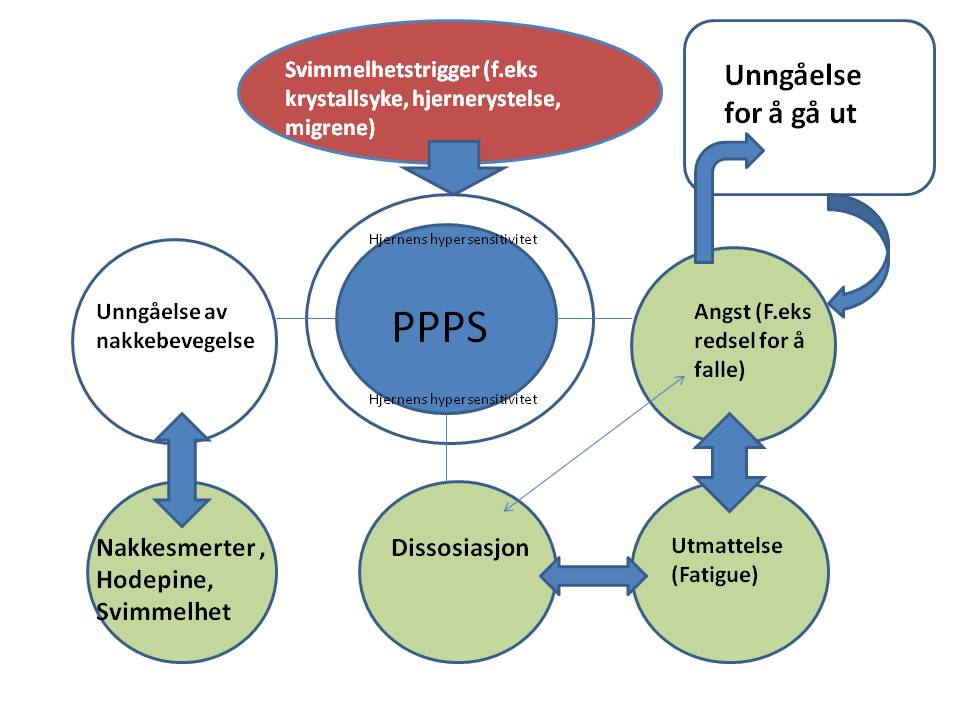Persistent postural-perceptual vertigo (PPPS) is a condition that can occur after a previous vestibular condition, such as an acute viral infection or benign positional vertigo (BPPV). PPPS is characterized by persistent dizziness and a feeling of unsteadiness, and symptoms can be exacerbated by certain body positions, walking and complex visual stimuli. In this article, we will explore what PPPS is, how it occurs and what can be done to reduce the symptoms and improve the quality of life of patients suffering from the condition.
Causes of PPPS
PPPS usually occurs after a vestibular condition, such as crystal sickness (BPPV) or another acute vestibular disorder. These conditions can cause damage or changes to the vestibular system in the inner ear, which the brain will attempt to down-regulate. This can lead to an increase in information from other sensory systems, such as the visual (eyes) and proprioceptive (joint sensation) systems, creating an imbalance.
PPPS can also occur after an event that causes acute vertigo, unsteadiness, dizziness or disturbance of balance, such as
- Mild traumatic head injury
- Dysautonomia
- Stroke
- Vestibular migraine
- Vestibular neuritis
Anxiety or mild depression may be present as comorbidities, but they are not symptoms of PPPS, as they were with BPPV. It is important to get a correct diagnosis in order to treat the condition and improve the quality of life for patients suffering from PPPS.
Symptoms of PPPS
The symptoms of PPPS include a persistent feeling of unsteadiness and dizziness without vertigo that lasts for at least 3 months. Symptoms are usually present more than every other day, and most patients have daily symptoms. Patients with PPPS usually experience worse symptoms when:
- In a position where they are standing or sitting upright
- Movements of the head or body
- When they are exposed to complex or fast-moving environments (such as driving on busy roads or being in places where there are many visual inputs)
Patients with PPPS typically exhibit chronic symptoms due to accumulated exposure to movement stimuli, making them more prone to relapse of symptoms. PPPS is a physiological disorder with psychological consequences, and it is important for patients to receive proper diagnosis and treatment to reduce symptoms and improve quality of life.
Diagnosis of PPPS
Diagnosing PPPS can be difficult, as the condition can co-exist with other vestibular disorders, making it important to seek help from a specialist.
Imaging diagnostics, such as CT scan or MRI will usually not show any physical abnormalities for patients with PPPS, and a diagnosis will be made based on neurological examination, the patient's symptoms and medical history. Anxiety and depression can affect the patient's symptoms.

Treatment of PPPS can vary depending on the cause of the condition. Exercises for balance, gaze fixation skills and vestibular rehabilitation can be helpful in reducing symptoms and improving balance and coordination. It is also important for patients with PPPS to avoid situations that may exacerbate symptoms.
Some patients may also benefit from medication to reduce anxiety or depression that can exacerbate symptoms. Patients with PPPS may also benefit from therapy, such as cognitive behavioral therapy, to learn how to manage their symptoms and reduce the worry that can lead to avoidance of situations that may exacerbate symptoms.
It is important for patients with PPPS to receive a thorough evaluation and treatment plan from a specialist to reduce symptoms and improve quality of life. Finding the right treatment for PPPS can take time, but with patience and cooperation between patient and practitioner, symptoms can be reduced and life can become more livable.


